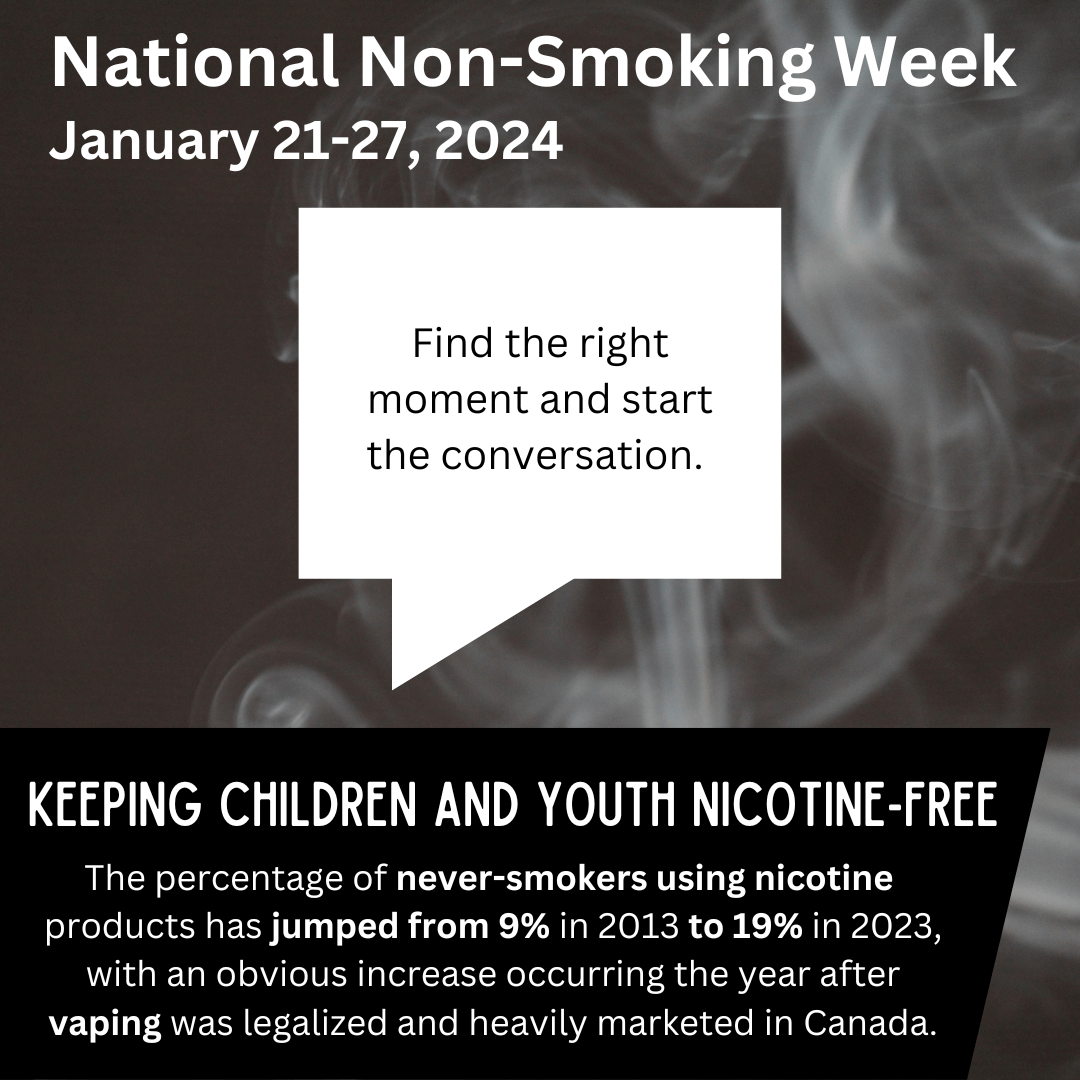National Non-Smoking Week 2024 – Keeping Children and Youth Nicotine-Free
National Non-Smoking Week, including Weedless Wednesday, began over 40 years ago as a way to raise awareness about the risks of smoking and to encourage smokers to quit smoking. The collective efforts of many health agencies, non-profits and governments have seen substantial reductions in smoking rates from roughly 50% of Canadians smoking in 1965 to about 10-15% today[1].

Since the mid-2000s, the tobacco industry has been trying to harness a new group of customers to maintain and even grow their bottom line. Naturally, their target audience is children and youth to maximize their long-term purchasing potential. Cigarette smoking amongst 15-19-year-olds has declined from roughly 11% a decade ago to about 4% today; however, the overall nicotine use in this age group has stayed relatively stable, hovering around 15-17%[2]. The percentage of never-smokers using nicotine products has jumped from 9% in 2013 to 19% in 2023, with an obvious increase occurring the year after vaping was legalized and heavily marketed in Canada. This suggests that youth who were not likely ever to smoke have become addicted to nicotine via vapes and other nicotine delivery systems such as nicotine pouches (i.e., Zonnic). Most would agree that these candy-flavoured products are being marketed directly to children and youth under the guise of tools to help smokers quit.
Vaping is not harmless, and evidence of harm continues to mount against these products, especially for children, youth and other non-smokers. A 2019 article from Physicians for a Smoke-Free Canada suggests that instead of comparing the harms of vapes to the harms of cigarettes, they should be considered “differently harmful.” There is good evidence to suggest that vaping causes harm to the lungs and cardiovascular system. Additionally, there is growing evidence that nicotine has negative effects on teen brain development. We must continue to work collectively to ensure youth are aware of these harms and fight back against Big Tobacco’s nasty tricks to market their harmful products to children and youth.
Staff in PMH continue to work on smoking and vaping prevention efforts with presentations in schools and the community, as well as working with staff in education to get the message out to youth. The target age of these prevention efforts is students in grades 5-8.
What can parents or others who work with youth do?
- Familiarize yourself with the risks of vapes or other emerging nicotine products such as nicotine pouches. Health Canada Tip Sheet
- Find the right moment and start the conversation.
- Recognize how tobacco companies market these products to young people and point them out to youth.
For people wanting to quit vaping, check out these apps and websites
- App: Stop Vaping Challenge
- App: Crush the Crave – Vape Edition
- App: Quash – Quit Vaping
- Website: www.smokershelpline.ca / Call: 1-877-513-5333 / Text: iQuit to 123456
- Website: https://teen.smokefree.gov/quit-vaping (US-based)
References:
1. https://uwaterloo.ca/tobacco-use-canada/adult-tobacco-use/smoking-canada/historical-trends-smoking-prevalence
2. https://smoke-free.ca/2023/CTNS-CTADS%20-%20Any%20Nicotine%20Use.pdf
3. https://smoke-free.ca/wp-content/uploads/2020/04/health-effects-of-vaping-2019-11-11a-2.pdf

